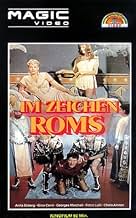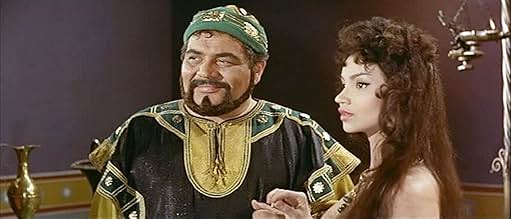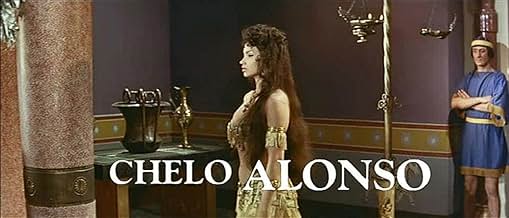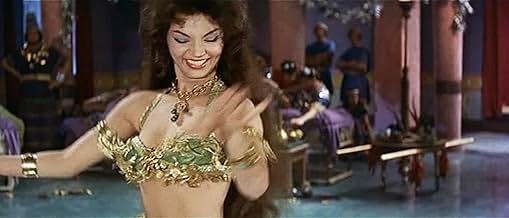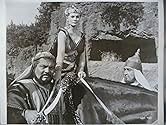CALIFICACIÓN DE IMDb
5.4/10
391
TU CALIFICACIÓN
Agrega una trama en tu idiomaZenobia, Queen of Palmyra, revolts against Rome and defeats the Roman troops - but she makes a big mistake when she falls in love with enemy officer Marco Valerio.Zenobia, Queen of Palmyra, revolts against Rome and defeats the Roman troops - but she makes a big mistake when she falls in love with enemy officer Marco Valerio.Zenobia, Queen of Palmyra, revolts against Rome and defeats the Roman troops - but she makes a big mistake when she falls in love with enemy officer Marco Valerio.
- Dirección
- Guionistas
- Elenco
Relja Basic
- Un soldato
- (sin créditos)
Angelo Casadei
- Il generale
- (sin créditos)
Aristide Catoni
- Un senatore
- (sin créditos)
Arturo Dominici
- Un ufficiale di Zenobia
- (sin créditos)
Opiniones destacadas
Made at a time when the popularity of the Sword and Sandal sub-genre was at its height, before giving way to the Spaghetti Western, this is a rare example of romance and court intrigue taking precedence over mindless, muscle bound heroics.
At one would expect it plays fast and loose with historical fact for although Queen Zenobia was defeated by the Romans and her life spared by Emperor Aurelian, there is no record anywhere of a relationship with a Roman General whilst the makers have gone so far as to give him the name of Marcus Valerius whose military exploits took place a century later!
The film's poster promises 'a wondrous spectacle bigger than anything you've seen before' which certainly applies to Anita Ekberg's chest whilst the exotic Chela Alonso, affectionately known as the Cuban H-Bomb, performs one of her hoochie-coochie dances guaranteed to quicken the pulse and send a rush of blood to the corpora cavernosa.
The film itself is something of a hotchpotch and betrays the input of various contributors. Credited director Guido Brignone became ill during production, fatally as it turned out so Riccardo Freda and a certain Michelangelo Antonioni were drafted in whilst the cinematography by uncredited Mario Bava is evident, especially in the dungeon scenes. Heaven only knows which segments Antonioni directed but there is no doubt that Freda was responsible for the climactic battle scene which will have animal rights activists foaming at the mouth. Credited composer Angelo Lavagnino provides a truly magnificent score.
The production is certainly well mounted and lavishly decorated whilst the version I saw has mercifully been spared the dreaded mid-Atlantic dubbing with Ekberg's Zenobia and Aurelius of Georges Marchal voiced by the ubiquitous Lydia Simoneschi and Emilio Cigoli.
Zenobia was a fascinating woman and by the standards of her time an enlightened ruler and one would hope that one day a film will emerge that will do her justice but that alas hardly seems likely.
At one would expect it plays fast and loose with historical fact for although Queen Zenobia was defeated by the Romans and her life spared by Emperor Aurelian, there is no record anywhere of a relationship with a Roman General whilst the makers have gone so far as to give him the name of Marcus Valerius whose military exploits took place a century later!
The film's poster promises 'a wondrous spectacle bigger than anything you've seen before' which certainly applies to Anita Ekberg's chest whilst the exotic Chela Alonso, affectionately known as the Cuban H-Bomb, performs one of her hoochie-coochie dances guaranteed to quicken the pulse and send a rush of blood to the corpora cavernosa.
The film itself is something of a hotchpotch and betrays the input of various contributors. Credited director Guido Brignone became ill during production, fatally as it turned out so Riccardo Freda and a certain Michelangelo Antonioni were drafted in whilst the cinematography by uncredited Mario Bava is evident, especially in the dungeon scenes. Heaven only knows which segments Antonioni directed but there is no doubt that Freda was responsible for the climactic battle scene which will have animal rights activists foaming at the mouth. Credited composer Angelo Lavagnino provides a truly magnificent score.
The production is certainly well mounted and lavishly decorated whilst the version I saw has mercifully been spared the dreaded mid-Atlantic dubbing with Ekberg's Zenobia and Aurelius of Georges Marchal voiced by the ubiquitous Lydia Simoneschi and Emilio Cigoli.
Zenobia was a fascinating woman and by the standards of her time an enlightened ruler and one would hope that one day a film will emerge that will do her justice but that alas hardly seems likely.
A joint venture of many countries get together to bring the famous Queen Zenobia, who ruled the large and powerful Palmyrene Kingdom around 270 AD, dealing with real events the movie exposes the Roman Consul Marcos Valerius (George Marchal) that instead attack Palmira would rather tries convince her a peace agreement with Rome, due it will cost many lives, however the dubious Zenobia (Anita Ekberg) insanely entrapped the Roman emissary as slave, advised by her Prime Minister Zemanzius (Folco Lulli) actually a grey eminency who nourish an alliance with Palmira's enemy the Persians.
Soon arises a mutual romance interest of the voluptuous and gorgeous Queen and the Roman nobleman's, it triggers a jealous of the bleak Zemanzius, meanwhile a Roman legion led by General Marcelus (Alberto Farnese) headed to Palmira aiming for release Marcus Valerious and seize the city, in the meantime Zemanzius set up a plot at behest of Persia that the battle between Palmira and Rome weaken both enabling Persia takes the whole Palmira's territory.
Aside all happenings worthwhile a look on the sexy dance provides by Chelo Alonso, as usually in those Peplum and Sword genre, the battles also exposes the roman machinery of war, years ahead of their enemies, as moving catapults throwing flaming stones and also spears, further a flawless strategic warfare, lastly rather than less important the wiser filmmakers tried capitalize on the beauty and sexy figure of Anita Ekeberg often exposing those voluminous airs bags and couple of legs to mesmerizing the viewers slobbering in every single frame where the Nordic Goddess appeared.
Thanks for reading
Resume:
First watch: 2024 / How many: 1 / Source: Youtube / Rating: 6.
Soon arises a mutual romance interest of the voluptuous and gorgeous Queen and the Roman nobleman's, it triggers a jealous of the bleak Zemanzius, meanwhile a Roman legion led by General Marcelus (Alberto Farnese) headed to Palmira aiming for release Marcus Valerious and seize the city, in the meantime Zemanzius set up a plot at behest of Persia that the battle between Palmira and Rome weaken both enabling Persia takes the whole Palmira's territory.
Aside all happenings worthwhile a look on the sexy dance provides by Chelo Alonso, as usually in those Peplum and Sword genre, the battles also exposes the roman machinery of war, years ahead of their enemies, as moving catapults throwing flaming stones and also spears, further a flawless strategic warfare, lastly rather than less important the wiser filmmakers tried capitalize on the beauty and sexy figure of Anita Ekeberg often exposing those voluminous airs bags and couple of legs to mesmerizing the viewers slobbering in every single frame where the Nordic Goddess appeared.
Thanks for reading
Resume:
First watch: 2024 / How many: 1 / Source: Youtube / Rating: 6.
I assume this isn't the easiest film for people to see. It isn't on video (to my knowledge), doesn't turn up at cinema's. In Australia it turns up occasionally on our foriegn language channel as part of their "sword & sandal" series. And my God, Anita Ekberg. Already a fan of her....um, talents. This film offers a rare view of more of her talents than before. Her outfits are very sensuous. Given the chance to meet her, I think my manhood would have shrunk away, as she is a very powerful icon, yet watched from a far, she is an Amazonian entity to adore. For serious film fans, you shouldn't feel guilty for watching this "trash", as Sergio Leone's name can be glimpsed in the writers credits!
I believe it is. Even reduced in it's intended length, the film has a number of curious elements to make it worth while even today. It was one of the first great productions from the "peplum" film industry, in this case in association with German, French, and Jugoslav studios. The army action relied entirely on men and horses, and also the war machines and traps that are here quiet realistic - catapults and multi-spear throwers, mainly (Stalin Organs, avant la lettre). Then, for arty fans, this is a good way to see where did Michelangelo Antonioni start perfecting his interior shots of dialogue; if you watch the German video copy (one of the best colors and editing around) without knowing the language (as I did), you'll notice that the interior shots are never boring - although you get to see some very poor "Egyptian" wall paintings... Finally, the two most prominent topics for most male viewers: Anita Ekberg riding a horse in mini-skirt, wearing daring low-cut evening dresses, and getting her man with a kiss, and a vengeful spear; Chelo Alonso proving in 4 minutes (longer, in the original version) how to be the focus of attention of the film industry with just one choreography... She mixes hand movements from Indian dance, with minimalist ballet and Turkish belly-dance to a perfection; she was famous as a dancer when discovered by film-makers, and with good reason.
Sign of the Gladiator was the first Italian epic to be released by American International Pictures. In 1959 their co-founders James H. Nicholson and Samuel Z. Arkoff took careful note how arch rival Joe Levine had purchased the Steve Reeves epic Hercules for just 100,000 dollars and then made millions. So, Jim and Sam picked up another Reeves winner, Goliath and the Barbarians, plus what was to become their first Italian offering, At the Sign of Rome.
Although this one doesn't have a man with a big chest, it makes up for it with a woman of similar attributes. Anita Ekberg plays the Queen of the desert, Xenobia (spelled with an "X" in the AIP credits), and the Italian costume designers were clearly under orders to ensure that her 40-inch bosom receives maximum uncoverage. The off-the-shoulder black evening gown that she seductively wears when arraigned before the Roman Senate could well be the same dress she wore in La Dolce Vita, made the same year. For younger viewers there is plenty of action and sword play, and the battle scenes were possibly one of the first occasions that stunt men allowed themselves to be set on fire. The hero suffers a spear straight to the chest, but in true western style he's as right as rain a few scenes later.
AIP decided that Sign of the Gladiator would make a more exciting title than At the Sign of Rome, even though there wasn't a single gladiator in sight. This difficulty was solved by re-writing the opening narration in which we are told that officers and generals of the Roman army were often recruited from the ranks of gladiators and that the foremost of the ex-gladiators was chosen to lead the army against Xenobia's hordes. Unfortunately, anyone who misses the opening narration will be waiting 85 minutes for a gladiator who never shows up. New York-based Titra Sound, regarded as the best dubbing company of all time, supply the English narration and dialogue, spoken by legendary voice actors George Gonneau, Peggy Lobbin and Norman Rose.
For the music score AIP would frequently bring in Les Baxter to entirely re-score the film from beginning to end. However, for Sign of the Gladiator AIP retained the original score by Lavagnino, except for the opening and closing titles which were re-shot with fresh footage. For the main title we see a scantily-clad showgirl dancing round a flaming altar, accompanied by Lavagnino's eerie music from the scene where the hero is tortured by thirst in the desert. To accompany the end title AIP made the bold (though hardly artistic) decision to finish with a pop song. "Xenobia" was composed by future film music giant Dominic Frontiere, with lyrics by Milton Raskin. The vocalist was the dependable Bill Lee who the previous year was chosen to dub the singing voice of John Kerr in South Pacific. American International Records released "Xenobia" as a single (AIR 501), but by way of an in-house joke named the backing group as the "Al Simms Sextet." (Simms was a senior executive at AIP and in charge of the music department). Milton Raskin had an unenviable task in devising pop lyrics for an Italian epic, but this is what he came up with: "Xenobia, lovely as the night / Eyes of misty light / Holding me close to you / Xenobia, lips of flame and fire / Burning with desire / More than I ever knew / Xenobia, hear me call to you from afar / I will go wherever you are / Will you open your heart? / For this I know – I am yours if you will command / Take my arm and you'll understand / What I knew from the start / Xenobia, do you lead me on? / Will my dream be gone? / Will it fade in the blue above? / Be mine alone, Xenobia, my love ."
This film may have started out as a serious historical exercise, but by the time Miss Ekberg and AIP had finished, it was a fun entertainment movie for all the family .and highly enjoyable. More importantly, the release made a healthy profit for AIP who were then able to buy up over 50 other Italian epics, many of them going straight to another company venture -- American International Television.
Although this one doesn't have a man with a big chest, it makes up for it with a woman of similar attributes. Anita Ekberg plays the Queen of the desert, Xenobia (spelled with an "X" in the AIP credits), and the Italian costume designers were clearly under orders to ensure that her 40-inch bosom receives maximum uncoverage. The off-the-shoulder black evening gown that she seductively wears when arraigned before the Roman Senate could well be the same dress she wore in La Dolce Vita, made the same year. For younger viewers there is plenty of action and sword play, and the battle scenes were possibly one of the first occasions that stunt men allowed themselves to be set on fire. The hero suffers a spear straight to the chest, but in true western style he's as right as rain a few scenes later.
AIP decided that Sign of the Gladiator would make a more exciting title than At the Sign of Rome, even though there wasn't a single gladiator in sight. This difficulty was solved by re-writing the opening narration in which we are told that officers and generals of the Roman army were often recruited from the ranks of gladiators and that the foremost of the ex-gladiators was chosen to lead the army against Xenobia's hordes. Unfortunately, anyone who misses the opening narration will be waiting 85 minutes for a gladiator who never shows up. New York-based Titra Sound, regarded as the best dubbing company of all time, supply the English narration and dialogue, spoken by legendary voice actors George Gonneau, Peggy Lobbin and Norman Rose.
For the music score AIP would frequently bring in Les Baxter to entirely re-score the film from beginning to end. However, for Sign of the Gladiator AIP retained the original score by Lavagnino, except for the opening and closing titles which were re-shot with fresh footage. For the main title we see a scantily-clad showgirl dancing round a flaming altar, accompanied by Lavagnino's eerie music from the scene where the hero is tortured by thirst in the desert. To accompany the end title AIP made the bold (though hardly artistic) decision to finish with a pop song. "Xenobia" was composed by future film music giant Dominic Frontiere, with lyrics by Milton Raskin. The vocalist was the dependable Bill Lee who the previous year was chosen to dub the singing voice of John Kerr in South Pacific. American International Records released "Xenobia" as a single (AIR 501), but by way of an in-house joke named the backing group as the "Al Simms Sextet." (Simms was a senior executive at AIP and in charge of the music department). Milton Raskin had an unenviable task in devising pop lyrics for an Italian epic, but this is what he came up with: "Xenobia, lovely as the night / Eyes of misty light / Holding me close to you / Xenobia, lips of flame and fire / Burning with desire / More than I ever knew / Xenobia, hear me call to you from afar / I will go wherever you are / Will you open your heart? / For this I know – I am yours if you will command / Take my arm and you'll understand / What I knew from the start / Xenobia, do you lead me on? / Will my dream be gone? / Will it fade in the blue above? / Be mine alone, Xenobia, my love ."
This film may have started out as a serious historical exercise, but by the time Miss Ekberg and AIP had finished, it was a fun entertainment movie for all the family .and highly enjoyable. More importantly, the release made a healthy profit for AIP who were then able to buy up over 50 other Italian epics, many of them going straight to another company venture -- American International Television.
¿Sabías que…?
- TriviaOfficials at the American distributor, American-International Pictures, decided that "Sign of the Gladiator" was a more exciting title than "Sign of Rome," even though there are no gladiators in the film. They simply had one of the characters make reference to "gladiator" in a line of the dubbed dialog,
- ErroresIn the desert scenes there are often agaves which were introduced from the Americas only after 1500.
- Citas
Zenobia, Queen of Palmira: If you have lied, the tigers at the temple will have a rich repast.
Marcus Valerius, Roman Consul: Your tigers will have to wait in vain.
- ConexionesFeatured in Kolossal - i magnifici Macisti (1977)
- Bandas sonorasXenobia
(end title song, US dubbed version)
(1959)
Music by Dominic Frontiere
Lyrics by Milton Raskin
Sung by Bill Lee
Played by the Al Simms Sextet
Selecciones populares
Inicia sesión para calificar y agrega a la lista de videos para obtener recomendaciones personalizadas
- How long is Sign of the Gladiator?Con tecnología de Alexa
Detalles
- Fecha de lanzamiento
- Países de origen
- Idioma
- También se conoce como
- Sign of the Gladiator
- Locaciones de filmación
- Productoras
- Ver más créditos de la compañía en IMDbPro
- Tiempo de ejecución1 hora 38 minutos
- Relación de aspecto
- 2.35 : 1
Contribuir a esta página
Sugiere una edición o agrega el contenido que falta

Principales brechas de datos
By what name was La carga de los gladiadores (1959) officially released in India in English?
Responda
